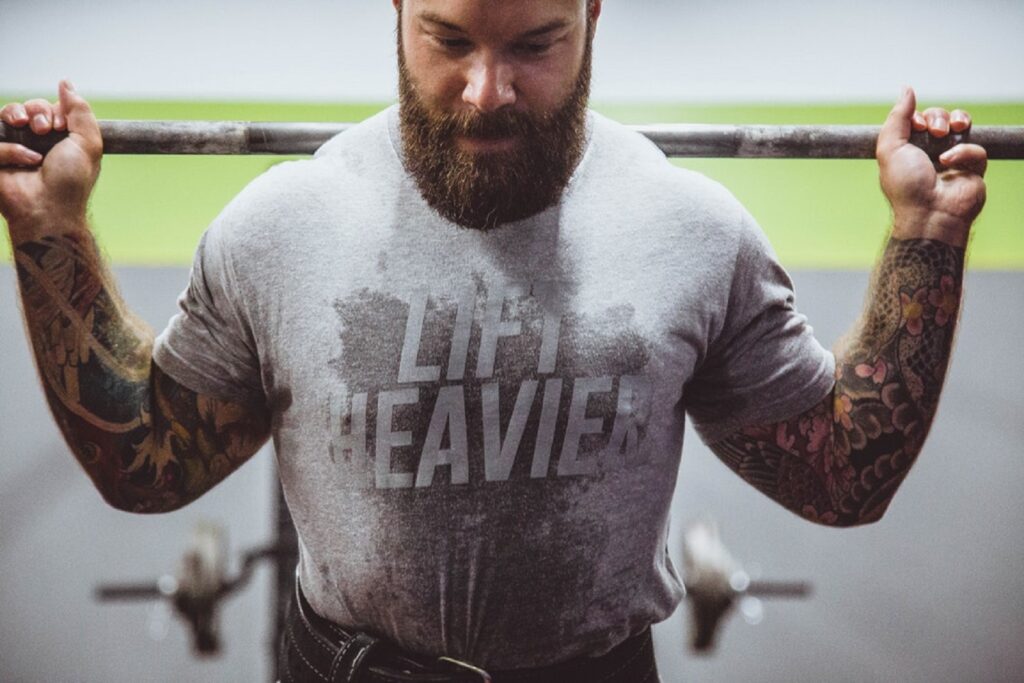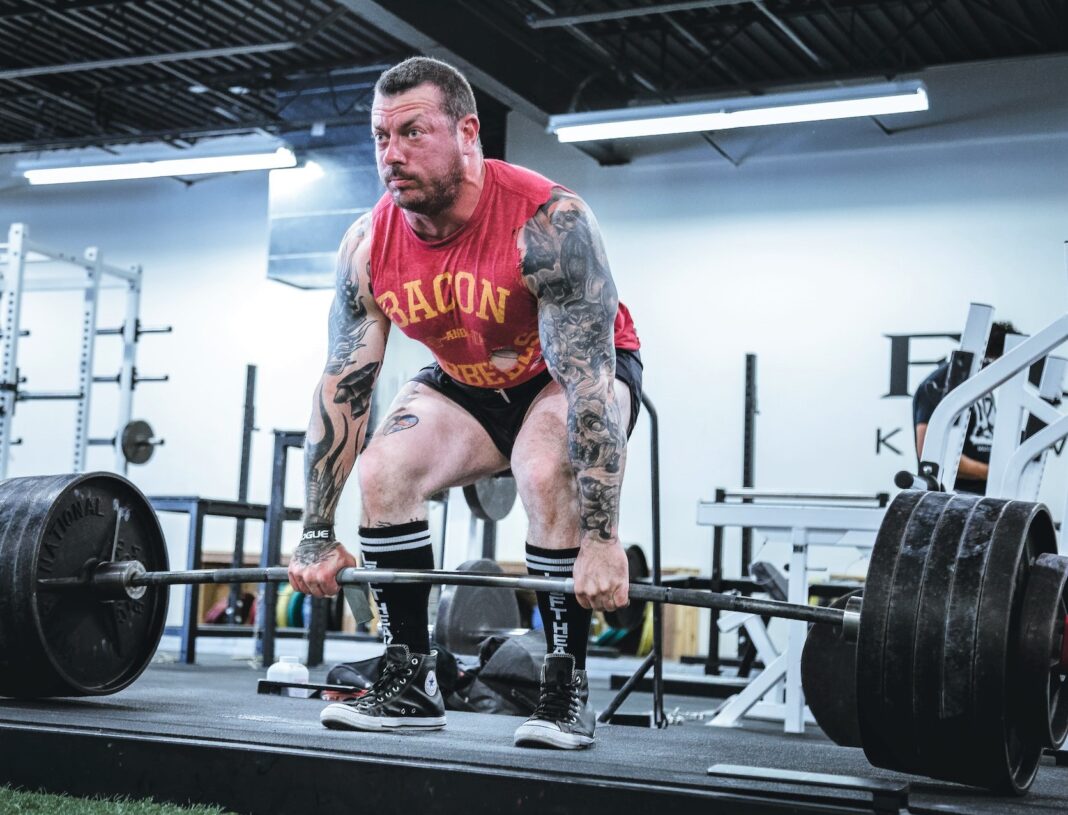Alora Griffiths
You snort an ammonia capsule, cringing at the synapse-stinging, you clap your chalked palms, forming a storm cloud, your buddy swats your back, hard, and again, harder, you shout, loud, and again, louder, and you stomp to the bar loaded with more than you’ve ever moved before, and….Most every serious weight-trainer, even bodybuilders, has a powerlifting fantasy. After all, most of us don’t want to just look strong. We want it all. Let’s examine how to best up your your numbers in the three powerlifts—bench press, squat and deadlift—as we break down the top five power training blunders.
POWER TRAINING MISTAKE #1: NOT CYCLING
Periodization is a fancy word for segmenting your training into progressive cycles, typically lasting eight to 12 weeks. For power gains, it’s virtually mandatory.
SOLUTIONS
✷ Set an attainable but challenging goal for an eight-week power cycle. Those with less experience (and strength) can shoot higher, but generally a 5% strength improvement is the sweet spot. So, if you can deadlift 400, aim for 420 eight weeks later.
✷ Do one workout per powerlift per week over those eight weeks, and pyramid the sets of the powerlift. For example, do squat (and leg exercises) on Mondays, bench press (and chest, shoulder, and triceps exercises) on Wednesdays, and deadlift (and back and biceps exercises) on Fridays.
✷ Starting with eight, decrease the reps of your pyramid’s apex set by one per week and increase the weight of that set. In this way, you’ll hit a max single in week eight.
✷ Plot out your cycle. Consult an online one-rep calculator so you can go from previously attainable marks in week 1 to your new target in week 8. For example, going from 315 for eight (projecting a 391 single) in week 1 to 375 for four in week 5 (projecting a 409 single) has you on target for a 420 single in week 8.
✷ If you’re missing marks week to week, reassess your targets.

POWER TRAINING MISTAKE #2: OVER-RELIANCE ON VERY LOW REPS
Many trainers assume if they want to up their one-rep lifts they should stick to the “singles scene,” focusing on max singles—and, perhaps, doubles and triples. With this mindset, a “high rep” set goes to six. The problem is the fewer reps you do the harder it is to eke out another one, and physically as well as psychologically it’s important to consistently improve.
SOLUTIONS
✷ Cycle your workouts in the manner prescribed above (decreasing apex reps in pyramids from 8 to 1 over 8 weeks), for this way you do a max single for each powerlift every eight weeks.
✷ Pyramiding your powerlifts allows you to work them through a full rep range. Though the lighter sets of a pyramid should not reach failure, strive to use progressively more weight in these sets. A sample pyramid might go like this: 225 x 12, 275 x 10, 315 x 8, 375 x 5.
✷ Keep reps for other exercises in the 6-10 range.
✷ Always employ the helping hands of at least one experienced spotter on maximum sets of bench presses and squats.
POWER TRAINING MISTAKE #3: NEGLECT OF ACCESSORY LIFTS
It’s not enough to merely work the muscles involved in the powerlifts via other exercises. You need to choose the right exercises and progressively boost your strength in those lifts, as well.
SOLUTIONS
✷ Where possible, choose secondary lifts that are free-weight, compound, or otherwise let you pack on the most iron, and therefore make gradual strength gains. Remember, it’s much easier to go from 150 lbs. to 155 than 30 to 35. So, for triceps, skullcrushers (for 3-4 sets of 6-10 reps) are better choices than one-arm dumbbell triceps extensions.
✷ To safely go heavy and make progressive gains, pyramid some secondary lifts. Military presses (working the front delts and triceps which are key to bench presses), leg presses (working the quads and glutes which are crucial to squats) and barbell rows (working the upper back muscles used in deadlifts) are three prime candidates for 12-10-8-6 pyramids.
✷ Don’t neglect your core. Your abs and lower back assist on bench presses and are especially crucial on squats and deadlifts. The cliché about a chain only being as strong as its weakest link is never more true than when powerlifting.
POWER TRAINING MISTAKE #4: FAILURE TO CORRECT WEAK POINTS.
Powerlifts usually fail at specific points. For bench presses, it’s the top half of the press when front delts and triceps take on more of the weight. For squats, it’s getting out of “the hole” (low position). And many deadlifters tire out as the bar rises and can’t lock it out. Additionally, some deads fail because the grip is the weakest link.
SOLUTIONS
✷ Correctly used, chains or bands place greater resistance on the top of bench presses. If you don’t have access to these, do bench presses in a power rack with supports set at approximately the halfway point in your range of motion and press the bar off the supports from a dead stop to full lockout on each rep. Do three sets of 8-10 after your full-range bench presses.
✷ One way to target the lowest position of squats is to squat until your butt touches a bench or box (set just below parallel) and then explode up. This will not only condition you to reverse the downward momentum as quickly as possible, but it will also help you learn how low to go. Do three sets of 8-12 after full-range squats.
✷ If you’re having trouble locking out deadlifts, set power rack supports at knee-level and pull the bar from there. Do three sets of 6-10 after full-range deadlifts.
✷ Those training for powerlifting should use an alternating grip for deadlifts (one hand overhand, the other underhand), but all others can use training straps to secure their grip.

POWER TRAINIG MISTAKE #5: BODYBUILDING
Power training is a completely different animal from bodybuilding. Power is strength and speed, two factors that are immaterial to success on a posing dais, just as the size and shape of muscles has no bearing in a lifting meet. When bodybuilders train for power they typically do their reps too slow and focus too much on feeling their muscles and too little on technique. They may also position themselves to best stimulate growth but not move the most metal.
SOLUTIONS
✷ Learn to explode the bar upward, never by bouncing, but by conditioning yourself to quickly transition from down to up in the squat and bench press, shepherding all the necessary muscles. The deadlift is the purest representation of strength because there is no downward momentum. Still, pull the bar off the floor with rapidity.
✷ As opposed to their bodybuilding positions, many people find wider stances and grips more effective for power, in part because this shortens their range of motion. However, it’s difficult to prescribe the same approaches for someone who is 5’2″ as someone who is 6’7″. Find the grips and stances that put you in the strongest positions.
POWER TRAINING LESSONS LEARNED
Cycle your power workouts, using progressively more weight for fewer reps over an eight-week period.
Pyramid up to your max sets.
Train for strength gains in free-weight, compound exercises that work the muscles used in the powerlifts.
Focus on eliminating weak spots: the lockouts of bench presses and deadlifts and the squat “hole.”
To maximize power, emphasize explosive strength over muscle growth.
Related content:
Powerlifting Injuries: Study Reveals Causes, Prevention, & More
















































